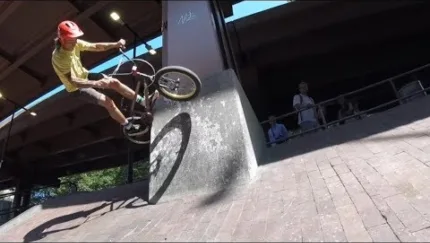
30 Years Of Hoffman Bikes - Pt 4: The EP
"By 1997, riders were asking for a smaller flatland bike with a shorter rear end."
29 Nov 2021

Day Smith.
Words by Brian Tunney - An exclusive extract from the 30 YEARS OF HOFFMAN BIKES zine.
"It’s the Empire Strikes Back to the Big Daddy’s New Hope…."

The Big Daddy was Hoffman Bikes’ first unofficial flatland frame. Designed by Kevin Jones and released initially in 1993, it was the standard, somewhat overbuilt, not going to break anytime soon flatland frame that helped push riders such as Jones, Chase Gouin and Day Smith into the stratosphere of progression.
For four years, which, in early ‘90s terms, was an eternity, the Big Daddy gained notoriety the world over following appearances in the Dorkin In York series and as Jay Miron and Dave Mirra’s frame of choice on the Hoffman Bikes team. And alongside the Standard Shorty, Homeless Soul Bro and Morales, it was basically one of a small handful of flatland bikes to ride in the early to mid 1990s.


But needs were beginning to change as the riding evolved. By 1997, riders were asking for a smaller flatland bike with a shorter rear end. Whereas the Big Daddy was designed to evolve decade progression, the EP was aimed more at rolling and spinning. According to fellow York Pa. Plywood Hood Leif Valin, who helped design the EP, “The EP was shorter than the previous flatland frame (rear end length) so it was aptly named like an EP record: shorter, fewer songs. The first head tube sticker on the EP was a record.”
To achieve a smaller frame, the rear end was shortened by over an inch (approximately) and engineered to accommodate rear wheel adjustment that spanned over an inch. To this end, the brake mounts were also made adjustable on the first EP. First, the EP brake mounts were slotted and moved either up or down, and later, the mounts were replaced by a cleaner, easier-to-remove brake plate. And as the years passed, tiny adjustments were made to the brake plate, including the switch from steel to aluminum. It was a fairly ingenious solution to brake alignment, and it worked brilliantly.
Of course, as flatland riding progressed through the late ‘90s, back brakes altogether were becoming more and more bygone as front wheel riding took off in new directions throughout the world. But the EP’s brake plate made that switch that much easier (and lighter).
While the Big Daddy will always be Hoffman’s first and most important step into flatland, the EP was just as important to the evolution of rolling and spinning that would follow. It’s the Empire Strikes Back to the Big Daddy’s New Hope…. - Brian Tunney
of 1
Check out the 30 year Anniversary line from Hoffman Bikes at hoffmanbikes.com
Previous
PRODUCTIVITY: HOFFMAN BIKES 30 YEAR ANNIVERSARY FRAMES
The 'Totally Awesome Jumper' and more...
Next
30 Years Of Hoffman Bikes - Pt 5: GACK
Bent axles. Remember those?
Related Content


















































